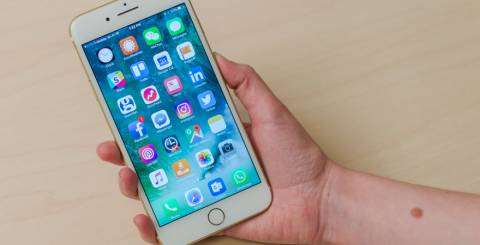What Does the Future Hold for the Smartphone Industry?

It seems like yesterday when Steve Jobs launched the first ever iPhone and gave rise to an entirely new generation of the cellphones. These phones had the capability to perform a wider range of tasks gradually replacing other devices in your life. In a span of ten years, the smartphone industry has seen humongous changes and astounding innovation with each new phone being way ahead than its predecessor when it comes to performance and speed.
The question which arises here is that what is the future of the smartphone industry? What can we expect from the business giants to produce in the next five to ten years? This is not an easy question to answer considering the fast pace at which technology is evolving. Yet, we would like to make some wild guesses based on the current trends and foresee where the smartphone industry is headed to.
Augmented Reality (AR)
The term AR refers to what we perceive through our senses especially sight when used in the context of computer technology. The sound, video, and graphics generated through the computer enhance our sensory input and make us believe them to be real. In simple words, AR combines our reality with some computer-generated content to make us believe that it is real.
The most common and famous example of this was the latest rage of Pokémon Go which was an entire game based on the concept of AR. It was a very basic form of AR technology which was used for entertainment purposes. On a greater scale, this technology has the ability to revolutionize our industries and facilitate the process of learning.
Another prime example is of IKEA coming up with an AR app which will help in enhancing the shopping experience of its customers. Through this app, the customers will be able to place furniture items in different areas of their house and determine whether they are a good buy or not. This is truly an advanced form of AR technology as the customer will already know whether they like a furniture item placed in a particular part of their house or not.
Flexible Screens
Quite recently, it made into news that Samsung is filling a patent for flip smartphones. The company is eager to bring this technology into consumer space rather than merely talking about it as a concept. In this case, the smartphones will be able to retain the large screen size which enables the users to enjoy their favorite movies and games while easily fitting into your pocket as well.
Other companies are also inclined to provide wearable smartphones to the users to maintain an edge in being innovative. For example, Nokia is conducting some research on a concept device which can be worn as a wristwatch but will unfold to bring a typical handset in front of you when required. The transformation from a watch to a smartphone and vice versa will depend on the nature of the task in which the users are engaging themselves.
3D Screens and Holograms
Despite the introduction of ‘Retina Display’ by Apple that literally shows us a resolution clearer than the human eye, we are still looking for further advancements in the field. Mobile manufacturing companies are nowventuring into 3D smartphone screens and are trying to leave behind the limitations which come with the 2D screens. Currently, there are a few 3D smartphones in the market including Motorola MY810, LG Optimus 3D, and Samsung’s AMOLED 3D.But what would be the next step after 3D?
There is a strong possibility of the next path being holographic projections. By this term, we refer to a combination of 3D features along with the projections of the smartphone. It was revealed by Mobiledia Network that last year at the Mobile World Congress, MasterImage 3D had showcased their ongoing development on a projection system which allowed the smartphones to display 3D holograms.
Do you know what these 3D holograms are capable of? You will be able to resize your photos by using your hands to enhance or compress them. It will also enable you to move objects by grabbing them and then moving them to the desired location.
Seamless Voice Control
Since ‘Siri’, seamless voice control has been receiving enough recognition from the masses with Google replicating the concept through ‘Google Assistant’ quite lately. Even Samsung has joined the bandwagon with the launch of its own voice control ‘Bixby’ in the Samsung Galaxy S8. This technology is quite advanced even now but the intention is to take it a step further.
There will be a time in a couple of decades when each smartphone will come equipped with its own AI which will be as advanced as Jarvis (Tony Stark/Iron Man’s personal assistant powered by AI). This would be nothing less than a miracle as we will have fully developed intelligence right in our hands which will be helping us in carrying out normal tasks.
Seamless voice control combined with gestures will bring interactivity with the smartphones to all new level. The users will be able to explore the various greater capabilities of these devices and achieve their goals and objectives with more ease. There is no denying that this will take the smartphone usage to an all new level of convenience and advancement.
The future of the smartphones greatly lies on the advancement in the operating systems like Android and iOS. The latest Android news and updates keep revealing the revolutionary changes which are taking place in the industry and predict the happenings of the future too.
Currently, there are 1.4 devices for every person existing on the planet and the number is going to increase with time in respect to the explosive growth in the industry. The future of all the industries is in the hands of the smartphones with more and more people shifting their focus from other devices and narrowing it down to a single one which is the smartphone. The current trends reveal a very promising future for this device.
Similar Articles
Modern businesses are drowning in communication overload, and much of that burden stems from outdated tools that simply can’t keep up
Building lending software isn’t just a technical project—it’s a business decision. Whether you're a fintech founder or part of a traditional lending institution trying to go digital, three questions will shape everything that follows
Learn why robust security is crucial for super app development. Explore key strategies and best practices for mobile app development security.
Walkie-talkies with an extensive reception capacity have changed significantly when it comes to portable communication by displaying cutting-edge features with seamless connectivity that covers more than just the state
USB-C technology has revolutionized the way we charge our devices, offering faster charging speeds, higher power delivery, and universal compatibility across multiple devices
Discover expert mobile app development strategies to create a viral app that attracts users and boosts engagement
Optimize app localization for iOS users across the EU with language, cultural, and regulatory adaptations. Engage users and boost retention with these tips!
Discover the top 10 mobile app development trends of 2024! Explore 5G, AI, AR/VR, blockchain, and more to stay ahead in the ever-evolving app development landscape.
With its triple-lens design and fantastic photo and video quality, the iPhone 11 Pro Max is extensively acknowledged for its superior camera system. But problems can occur with also one of the most advanced technologies. If you're having issues with the iPhone 11 pro max camera lens, knowing the typical problems and how to repair them









